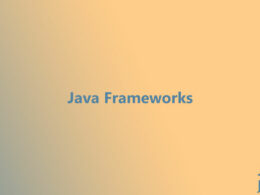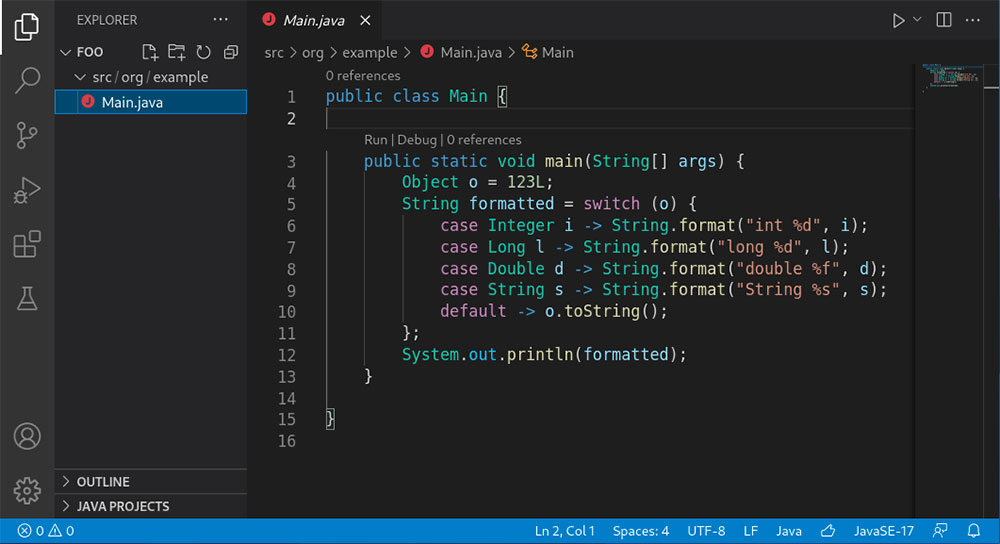Master Your Build: Essential Java Build Tools

Effortlessly, a symphony of codes transcend into a masterpiece—such is the art of Java build tools. The finesse of crafting software is often unsung, yet it dwells at the heart of every seamless application we encounter.
Within these digital tapestries lies a complex weave of automation scripts, dependency resolution, and the subtle intricacies that Java developers navigate daily.
Dive into this trove where, beyond the mere act of compilation, one orchestrates the ballet of build lifecycle and task execution. The quintessence of this journey plummets deeper than ones and zeros—it’s about creating with efficiency, precision, and a touch of brilliance.
This article unfurls the secrets hidden within Java build tools such as Maven, Gradle, and Ant, elucidating how they champion the complexity of continuous integration and software lifecycle management.
Through this expedition, readers will gain mastery over these pivotal instruments, ensuring that with each line of code, they are constructing more than a program; they are crafting a legacy.
Java Build Tools
| Java Build Tool | Build System/Tool Type | Build Language | Main Features/Use Cases | Ease of Integration |
|---|---|---|---|---|
| Jenkins | Continuous Integration | Groovy-based DSL | Highly customizable CI/CD. Plugins for various tools. | Moderate to High |
| Gradle | Build Automation Tool | Groovy or Kotlin DSL | Incremental builds, performance, and flexibility. | High |
| Apache Maven | Build Automation Tool | XML | Standardized build process, dependency management. | Moderate |
| TeamCity | Continuous Integration | Kotlin-based DSL | Professional CI/CD with many built-in features. | High |
| Bazel | Build Automation Tool | Starlark (Python-like) | Optimized for large codebases with incremental builds. | Moderate |
| Travis CI | Continuous Integration | YAML | Hosted CI/CD, integrates well with GitHub. | High (for GitHub projects) |
| sbt | Build Automation Tool | Scala | Specifically tailored for Scala, incremental builds. | Moderate to High (for Scala) |
| Apache Ant | Build Automation Tool | XML | Procedural build scripts, extensible with Java classes. | Low |
| Bamboo | Continuous Integration | Built-in GUI / Java | Integrates well with Atlassian products. | Moderate |
| CMake | Build Automation Tool | CMake scripting language | Cross-platform builds, primarily for C/C++ projects. | Low (For Java projects) |
Jenkins
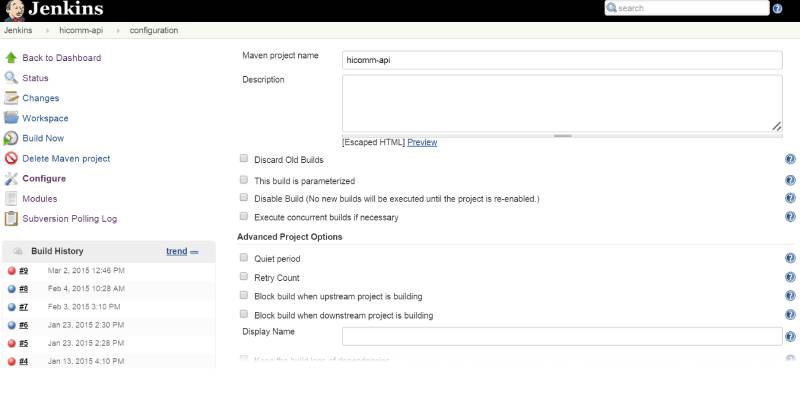
Jenkins stands as an open-source marvel in the realm of automation servers. Picture a maestro conducting an orchestra; Jenkins ensures that the symphony of software development processes—integration, delivery, deployment—operates without a hitch. Its versatility lies in orchestrating complex workflows via pipelines.
Best Features
- Open-source and free
- Extensive plugin ecosystem
- Robust community support
- Integration with virtually any tool
What we like about it:
Jenkins excels with its continuous integration capabilities. The cherry on top? Its vibrant community constantly contributing to a sea of plugins, enhancing flexibility.
Gradle
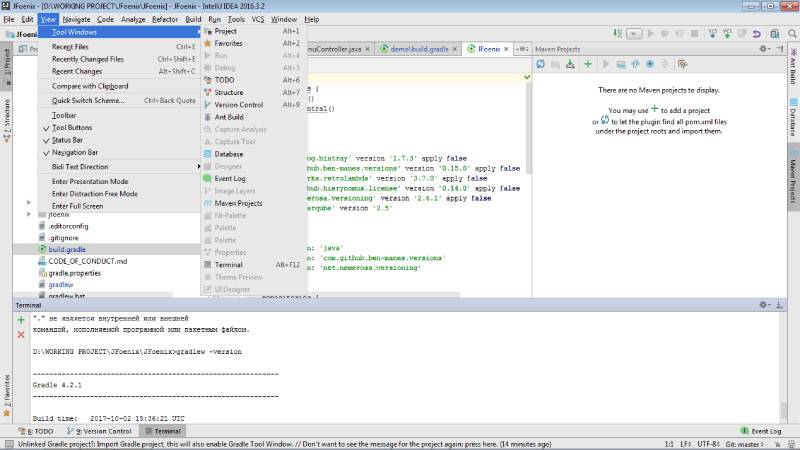
With Gradle, the build automation process whispers flexibility. It dances gracefully across multiple languages but finds its true rhythm with Java. Laden with features, it harnesses the Groovy scripting language to make each build a bespoke work of art.
Best Features
- Incremental builds
- Groovy-based DSL
- Performance optimization
- Customizable build logic
What we like about it:
Gradle’s incremental build feature is a showstopper, turning hours of work into minutes by only processing the latest changes.
Apache Maven
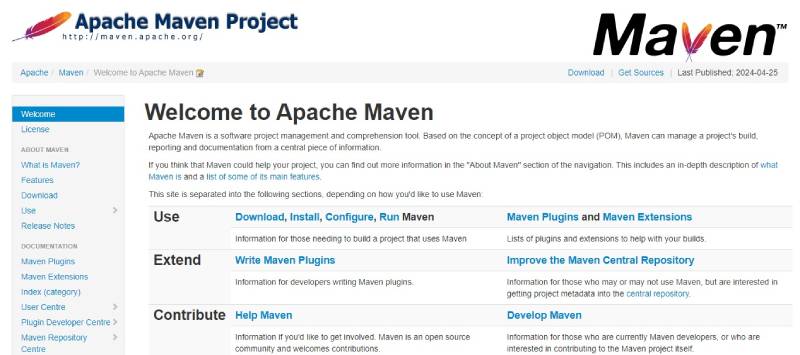
In the amorphous world of software, Maven brings order. It streamlines the build process using a POM file, and its convention-over-configuration approach provides a standardized framework for project management, dependency management, and a grand repository of libraries and plugins.
Best Features
- Standard project structure
- Powerful project management
- Dependency management system
- Extensive plugin library
What we like about it:
Maven’s superpower indeed lies in its dependency management. It automates the inclusion of libraries, ensuring all cogs in your machine fit perfectly.
TeamCity
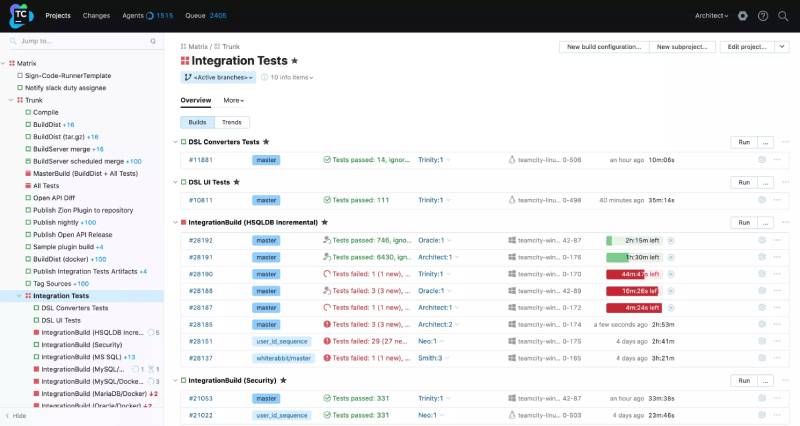
TeamCity serves as a fortress of continuous integration and delivery. Developed by JetBrains, this polished tool offers a tapestry of advanced features with what feels like an out-of-the-box experience. It promotes collaborative build progress with robust version control integrations.
Best Features
- Real-time build progress
- Pre-tested commit
- Comprehensive VCS support
- Professional support by JetBrains
What we like about it:
Its ability to facilitate pre-tested commits, ensuring that only verified changes are visible to the team, sets TeamCity apart.
Bazel
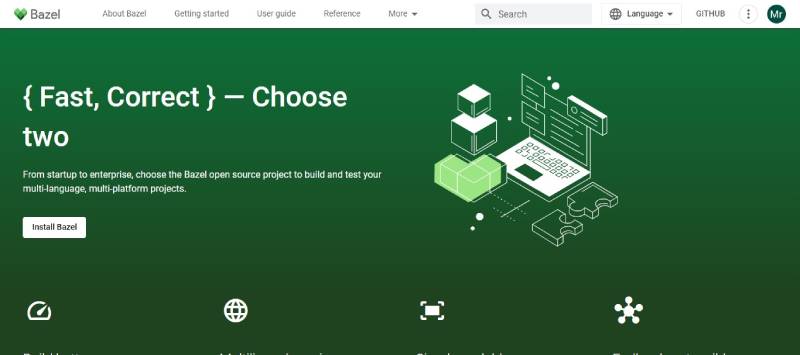
Bazel—Google’s brainchild—is the Phoenix of build tools, rising to oversee projects of mammoth sizes. It leverages advanced caching strategies and finely tuned dependency analysis to ensure repeatable builds, enabling monumental codebases to scale with ease.
Best Features
- Scalable build tool
- Supports multiple languages
- Parallel builds
- Reproducible build processes
What we like about it:
Bazel’s true strength unfolds in its scalability. The larger the project, the more Bazel shines, a favorite among giants.
Travis CI
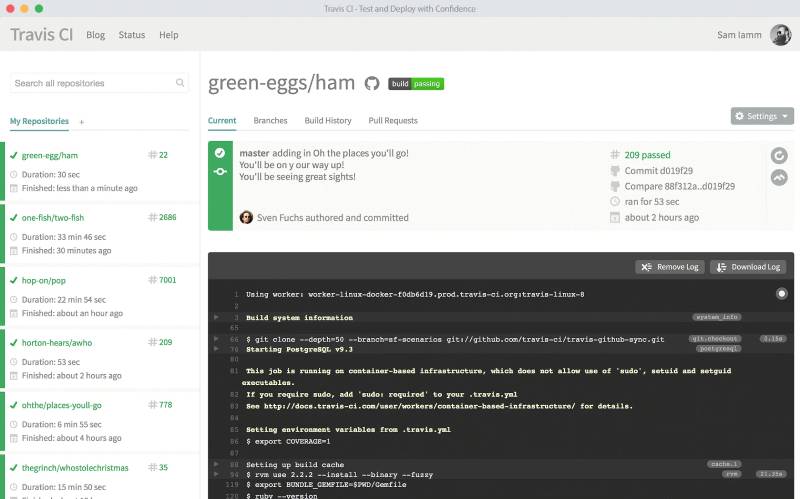
Embark on a journey with Travis CI, a pioneer in hosted continuous integration services. Seamless integration with GitHub and a focus on open-source communities make Travis CI not just a tool but a dependable companion for developers striving for excellence with every commit.
Best Features
- Easy to set up
- GitHub integration
- Well-suited for open-source
- Multiple language support
What we like about it:
The delightful ease with which Travis CI syncs with GitHub makes it a favorite, offering a smooth runway for new code to take flight.
Sbt
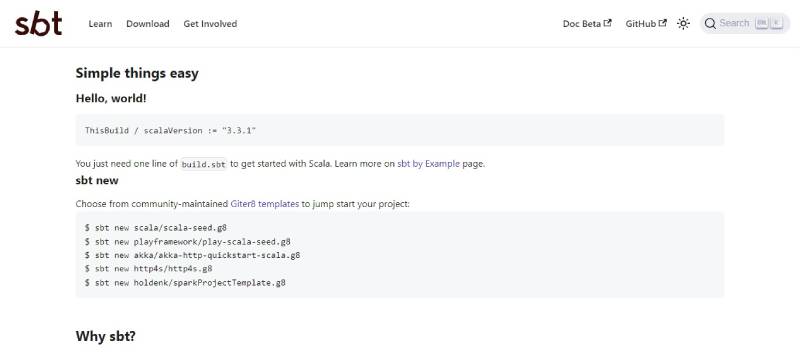
For the inquisitive minds drenched in Scala, sbt is the guiding star. It’s not just any build tool; it’s a task execution engine designed to wrangle Scala and Java projects alike. Sbt’s interactive console and incremental compilation turn it into a dynamo of productivity.
Best Features
- Scala-centric design
- High-level build description
- Interactive shell
- Incremental compilation
What we like about it:
Its devotion to incremental compilation stands out, ensuring that only the necessary parts are recompiled, saving time—hugely beneficial in complex projects.
Apache Ant
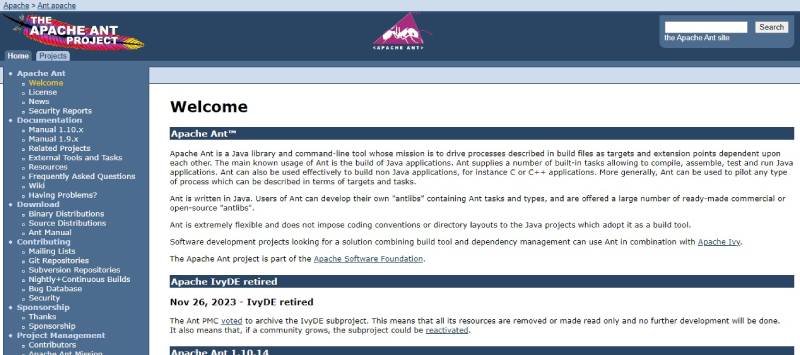
Ant navigates the sea of code with an XML map. It’s the time-tested build tool that delves into the granularity of build scripting. Venerable yet versatile, it leaves the reigns of customization firmly gripped in the hands of developers.
Best Features
- Precise control over builds
- Robust and mature tool
- Platform independent
- Extensive flexibility with XML
What we like about it:
The unprecedented level of control and fine-grained build management—it’s a builder’s dream come true for meticulous code architects.
Bamboo

Bamboo joins the ranks with seamless continuous integration and delivery, harmonizing with the Atlassian suite of tools. It features a sophisticated set of metrics to track performance, promising a bright beacon of insight into the health of your deployments.
Best Features
- Built-in deployment support
- Environment management
- Integration with Atlassian products
- Comprehensive build telemetry
What we like about it:
Bamboo’s most vaunted feature is its rich integration with other Atlassian tools, encasing the build environment in a cocoon of familiarity and performance metrics.
CMake
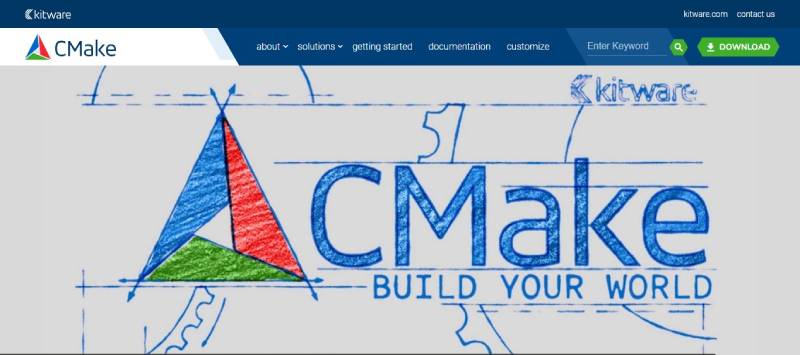
CMake constructs a foundation for cross-platform building. It’s the tool that whispers code into the ears of multiple operating systems, translating into binaries that thrive within numerous environments—a polyglot of the build world.
Best Features
- Cross-platform support
- Open-source
- Out-of-source builds
- Customizable build configurations
What we like about it:
Its cross-platform capabilities are beyond praise—with CMake, write once, and speak to many operating systems, a true lingua franca for builders.
FAQ On Java Build Tools
What exactly are Java build tools?
Imagine a toolbox where every gadget from a hammer to a screwdriver is designed to piece together your Java project efficiently.
These tools automate the compilation, build process, and deployment phases, making life easier by handling mundane tasks with the precision of a seasoned craftsman. Maven and Gradle lead the pack here.
How do Java build tools improve project management?
Within the digital labyrinth of source code, Java build tools act as the lighthouse, guiding the way to artifact repository havens.
They streamline workflows, magnify productivity, and leverage version control systems to herald undisputed harmony in the coexistence of countless lines of code dancing in an intricate ballet.
Why is Maven considered a cornerstone among Java build tools?
Maven, with its Project Object Model (POM) and lifecycle management, stands as an exemplar in the realm of build tools.
It standardizes the build process, provides an organized structure through conventions, and boasts an expansive realm of plugins and extensions, making it a consultant’s first pick.
Is Gradle better than Maven and why?
“Better” is subjective, yet Gradle garners accolades by wielding Groovy’s dynamism for scripts, enriching the build automation experience.
Its incremental builds save time, and the flexibility offered is colossal, outshining Maven’s rigidity. It thrives by adapting to the sprawling needs of the contemporary builder.
How does Apache Ant differ from other Java build tools?
Ant, the pioneer, forgoes convention over configuration unlike Maven, offering builders a blank canvas upon which to script their constructions.
It thrives through simplicity and the power of XML, demanding meticulous craft from the builder to define each build task step-by-step, crafting build scripts as they deem fit.
What role does Jenkins play in conjunction with Java build tools?
Jenkins, the automation server extraordinaire, performs a ballet alongside build tools, orchestrating continuous integration and continuous delivery.
It turns fledgling code pushes into a flawless symphony of deployment through automated builds, tests, and deployment processes, assuring a steadfast flow of updates to applications in production.
Can Java build tools aid in testing and bug tracking?
Indubitably, these tools are the sentinels at the gates. They integrate with frameworks like JUnit for test automation, ensuring every build is scrutinized under vigilant tests.
Coupled with task execution from tools like JIRA, the march towards bug minimization and code quality feels less like a siege and more of a triumph.
Are there plugins and extensions available for Java build tools?
A realm of plugins and extensions lays at the fingertips of the savvy builder. With this arsenal, one can enrich their build tool capabilities, from code analysis to enhancing dependency management.
It’s a playground for customization, where each plugin serves as a power-up for your build tool of choice.
How do Java build tools fit into the DevOps culture?
In the vigorous DevOps ecosystem, Java build tools are the heartbeat. They propagate the DevOps credos of automation, monitoring, and collaboration, ensuring a fluent transition from code repository to deployment.
They are the engineers of bridges between teams, where the amalgamation of operations and development crafts excellence.
What is the future of Java build tools?
The horizon shines with innovations like AI and machine learning steering the Java build tools towards smarter build automation and environment configurations.
The future holds an era of predictive analytics and intricate optimizations, ensuring that build tools become ever more intuitive and aligned with the developer’s intentions.
Conclusion
In the canvas of web creation, where the abstract becomes tangible, Java build tools emerge as the silent guardians of efficiency. Magnificent structures, born from code, owe their resilience to these vigilant sentinels.
- Maven, with its structured approach, navigates the intricacies of project models.
- Gradle flexes its muscle with dynamic scripting capabilities.
- Ant harnesses the supremacy of XML to grant the power of manual finesse.
- Each plays a part in the grand symphony of DevOps, where continuous integration and deployment form the crescendo of success.
Let’s fold this echo of wisdom into a takeaway symphony—the right tool weaves simplicity into complexity, making the arduous task of building software a harmonious endeavor. Armed with knowledge and the right toolset, envision a future sculpted with precision, where every build is a testament to prowess and every deployment marks a milestone in digital craftsmanship.
If you liked this article about Java build tools, you should check out these articles also:
- Step Up Your Earnings: Apps That Pay You to Walk
- Word Puzzles Galore: Dive Into Apps Like Wordle
- Language Learning Excellence: Apps Like Duolingo Reviewed
- The Difference Between Methods and Functions in JavaScript - June 24, 2024
- Sing Along: Karaoke and Music Apps Like Smule - June 23, 2024
- How to Optimize JavaScript Function Call Performance - June 23, 2024







